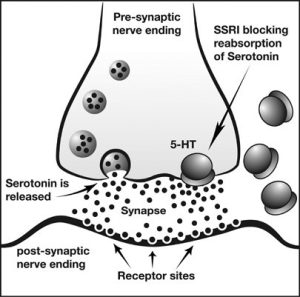Although many people steal in response to economic hardship, either perceived or actual, some individuals only steal to satisfy a powerful urge. These individuals may have an impulse control disorder known as kleptomania. People with kleptomania experience a sense of relief from stealing, so they steal to get rid of their anxiety (Talih, 2011). The prevalence of kleptomania in the U.S. is estimated to be 6 people per 1000, which is equivalent to more than 1.5 million kleptomaniacs in the U.S. population (Aboujaoude et al., 2004).
What exactly causes this impulse to steal? Kleptomania has a range of biological, psychological, and sociological risk factors. One of the main biological factors has to do with neurotransmitters, such as serotonin (Sulthana, 2015). Serotonin plays an important role in our bodies, contributing to emotions and judgment, and low serotonin levels have been linked to impulsive and aggressive behaviors (Williams, 2002). The serotonin system is also thought to be involved in “increased cognitive impulsivity,” as has been observed in individuals with a higher number of kleptomania symptoms (Ascher & Levounis, 2014).

Throughout the nervous system, serotonin transporters (SERT) take up serotonin that is released from neurons (Rudnick, 2007). These transporters can also be found on blood platelets and take up serotonin from the blood plasma (Mercado & Kilic, 2010). We can study these particular transporters to better understand the levels of serotonin in one’s blood and how that relates to their level of impulsiveness.
A 2010 study looked into the relationship between the platelet serotonin transporter, impulsivity, and gender. They found that while women were, in general, more impulsive than men, there was only a positive correlation between the number of transporters and impulsivity in men. This means that higher amounts of platelet serotonin transporters and lower levels of serotonin are related to more impulsivity in men, but not in women. It was also found that higher amounts of SERT transporters were linked to more “aggressive” behaviors. The authors came to the conclusion that, even though women were found to display more impulsivity than men, serotonin plays a larger role in impulsivity with men than it does with women (Marazziti et al., 2010).

Understanding the relationship between serotonin and impulsivity with kleptomania has helped pioneer specific treatments, including Selective Serotonin Reuptake Inhibitors (SSRIs). Impulsivity is linked to low levels of serotonin, so SSRIs fix this by limiting the reuptake of serotonin through the blockage of serotonin transporters, leading to the buildup of serotonin in the synapse (Sulthana, 2015). There is no cure for kleptomania, but SSRIs help to control the impulse to steal.
Overall, kleptomania is a secretive disorder, for which many people don’t seek help due to the legal system and the social stigma around theft. Thus, very little is known about what causes kleptomania, but trying to understand it through its link with neurotransmitters has uncovered potential causes and helped develop treatments.
References
Ascher, M. S., & Levounis, P. (Eds.). (2014). The behavioral addictions. American Psychiatric Publishing.
Aboujaoude, E., Gamel, N., & Koran, L. M. (2004a). Overview of kleptomania and phenomenological description of 40 patients. Primary Care Companion to The Journal of Clinical Psychiatry, 6(6), 244–247. https://www.ncbi.nlm.nih.gov/pmc/articles/PMC535651/
Marazziti, D., Baroni, S., Masala, I., Golia, F., Consoli, G., Massimetti, G., Picchetti, M., Dell’Osso, M. C., Giannaccini, G., Betti, L., Lucacchini, A., & Ciapparelli, A. (2010). Impulsivity, gender, and the platelet serotonin transporter in healthy subjects. Neuropsychiatric Disease and Treatment, 6, 9–15. https://www.ncbi.nlm.nih.gov/pmc/articles/PMC2951061/
Mercado, C. P., & Kilic, F. (2010). Molecular mechanisms of SERT in platelets: regulation of plasma serotonin levels. Molecular interventions, 10(4), 231–241. https://doi.org/10.1124/mi.10.4.6
Rudnick, G. (2007). Sert, serotonin transporter. In S. J. Enna & D. B. Bylund (Eds.), XPharm: The Comprehensive Pharmacology Reference (pp. 1–6). Elsevier. https://doi.org/10.1016/B978-008055232-3.60442-8
Sulthana, N., Singh, M., & Vijaya, K. (2015). Kleptomania-the Compulsion to Steal. Am. J. Pharm. Tech. Res, 5(3).
Talih, F. R. (2011b). Kleptomania and potential exacerbating factors. Innovations in Clinical Neuroscience, 8(10), 35–39. https://www.ncbi.nlm.nih.gov/pmc/articles/PMC3225132/
Williams, Julie. Pyromania, Kleptomania, and Other Impulse-Control Disorders. Enslow, 2002.
